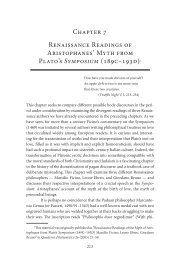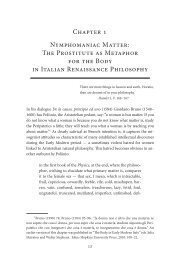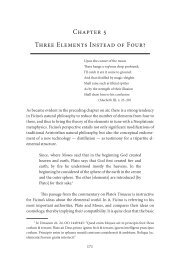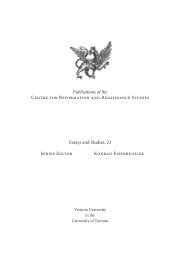Chapter 2 Matter as a Mirror: Marsilio Ficino and Renaissance ...
Chapter 2 Matter as a Mirror: Marsilio Ficino and Renaissance ...
Chapter 2 Matter as a Mirror: Marsilio Ficino and Renaissance ...
You also want an ePaper? Increase the reach of your titles
YUMPU automatically turns print PDFs into web optimized ePapers that Google loves.
<strong>Matter</strong> <strong>as</strong> a <strong>Mirror</strong> 89<br />
By linking the ide<strong>as</strong> of deception, reproduction of an image, <strong>and</strong><br />
childbirth, the mirror in the female body becomes a highly concise figuration<br />
of <strong>Ficino</strong>’s ambivalent attitude towards matter <strong>as</strong> a receptacle of all forms.<br />
It is precisely the neutrality of the mirror (so desperately argued for in this<br />
partenogenetic m<strong>as</strong>culine discourse), its capacity to receive any form whatsoever,<br />
<strong>and</strong> its unlimited potentiality that poses a threat to domination by form.<br />
There is an obviously close conceptual relationship with the materia meretrix<br />
metaphor discussed in chapter one. The womb is to be isolated not only from<br />
insemination by other men, but also from alien images, phant<strong>as</strong>mata that<br />
enter the body through the liver. The p<strong>as</strong>sive <strong>and</strong> hence female mirror is<br />
imprinted <strong>and</strong> subsequently falls into danger of begetting monsters <strong>as</strong> well<br />
<strong>as</strong> demi-gods. Viewed from this perspective, <strong>Ficino</strong>’s elaborate metaphysical<br />
theory of reflection turns out to be an index for the patriarchal anxiety about<br />
the legitimacy of the offspring. 135<br />
An important consequence of these many <strong>and</strong> divergent functions<br />
of the mirror is that the concepts of reflection <strong>and</strong> imprint become interchangeable.<br />
As a womb may receive the stamp of a form in the way an image<br />
is reflected in a mirror, so conversely the looking-gl<strong>as</strong>s may be inscribed<br />
with forms, retain <strong>and</strong> eventually even transform them. In the latter c<strong>as</strong>e, the<br />
womb (which previously had been explained by analogy to the mirror) demonstrates<br />
an occult property of reflecting surfaces, namely that of retaining<br />
<strong>and</strong> even transforming images. In an amazingly elliptical argument structure,<br />
both mirror <strong>and</strong> womb reinforce the concept of transformative reflection that<br />
structures all sorts of physiological functions <strong>and</strong>, at the same time, explains<br />
perience, or linguistic trope, sexual union remains the most compelling <strong>and</strong> most primal<br />
instance of the act of knowing. Even when unrecognized by metaphor, the experience of<br />
knowing is rooted in the carnal. It does not, however, remain there. What cl<strong>as</strong>sically distinguishes<br />
knowledge is its essential thrust away from the body, its ambition to transcend<br />
the carnal. Mind is not simply immanent in matter: it is transcendent over it. All visions<br />
of knowledge must accordingly struggle with the dialectic between immanence <strong>and</strong> transcendence.<br />
What is especially striking is how often the metaphoric field for this struggle<br />
is that of sex <strong>and</strong> gender, <strong>and</strong>, I shall argue, how deeply these metaphors have influenced<br />
the disciplines of knowledge.”<br />
135 On the powers of the imagination <strong>and</strong> its ability to infect <strong>and</strong> contaminate, see<br />
Theologia XIII, 4: II, 233–235. “L’affaire est claire: si la femme est le miroir de l’homme,<br />
[…] elle ne possède en propre nulle lumière; mais c’est surtout que, comme tout principe<br />
féminin, elle est la matière à quoi le mâle impose forme, comme l’artisan qui modèle la cire<br />
ou la glaise, frappe ou cisle le métal, façonne le bois et sculpte la pierre.” Frontisi-Ducroux<br />
(1997) 129–130.







